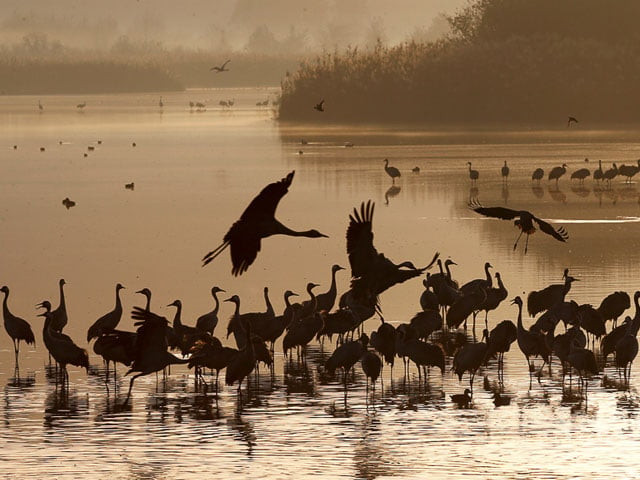Migratory birds in danger as illegal hunting persists in Sindh
Number of birds to be hunted per licence reduced
Migratory birds coming from Siberia are hunted in the province. PHOTO: FILE
KARACHI:
As soon as winter approaches, hunting activities begin without any regulation. A number of influential people, along with their family and friends, hunt migratory birds in the absence of relevant permits required.
The season starts in October with birds from Siberia moving to their wintering grounds in the Rann of Kutch until early March. During this period, some birds settle in Sindh and Balochistan for a short time.
A social activist living on the edge of Pakistan’s biggest natural lake, Manchar Lake, Mustafa Mirani said that hundreds of thousands of birds used to visit Sindh along the international avian route called the Indus Fly Zone.
“They used to stay here for more than six months from October to March,” he said, but now these migratory birds are not seen even at Manchar Lake, once the largest reservoir of migratory birds.
“These birds are being hunted illegally and sold in markets, which is a gross violation of the law,” he told The Express Tribune. He questioned how Grade-eight and nine officials of the wildlife department could check influential people like MNAs and MPAs.
Qataris among 12 arrested for illegally hunting in Balochistan
Mirani mentioned that 102 species of migratory birds were recorded by him up to two decades ago and the number has currently reduced to just eight in the surroundings of Manchar Lake. “The performance of the wildlife department is poor. They do not conduct a yearly census and just compile old figures without even going in the field,” the activist lamented.
Consultant ecologist Rafiul Haq said that vegetation will be delayed due to a lack of birds. “The migratory birds move away if they feel that the conditions are not favourable for them,” he said, adding that unchecked hunting is an attack on a vital component of our ecosystem. According to Haq, migratory birds play an important role in terms of seeds dispersal, pollination and other services by supporting biological processes.
Trophy hunting quota for new season announced
The Sindh wildlife department has also issued a hunting schedule under Section 41(2)(e) and Section 40(ii) of the Sindh Wildlife Protection Ordinance, 1972. The hunting season that started from November 19 will continue till January 21. According to the Deputy Wildlife Conservator Taj Mohammad Shaikh, hunting days in Sindh have been reduced to only Sundays in comparison to two days a week last year.
The number of birds allowed to be hunted has also been reduced to five partridges per shooting licence while a party consisting of four or more licences can hunt up to 20 partridges each. Five is the number of sandgrouses per shooting licence allowed for hunting, whereas 50 quails per shooting license with eight ducks, coots, moorhens, snipes, stints, dunlins, godwits, fuff red, shanks or curlews each are allowed. However, protected species like spot-bill, cotton teal, lesser whistling teal and marbled teal are prohibited for hunting.
“Up to eight people have been sent notices for exceeding the hunting limit and later posting photos on social media websites,” Shaikh said, adding that a fine of up to Rs50,000 can be imposed for not following the rules. He maintained that most of the times it is difficult to verify who was involved in the hunting and when it was done.
Hunting allowed across province sans Cholistan
According to deputy sanctuary warden Adnan Hamid Khan, there are 400 registered hunters in Sindh with hunting licences, which can easily be acquired for Rs2,500. He added that according to Section 34-C of the Sindh Wildlife Protection Ordinance, they can send notices to those who post their hunting photos and videos on social media as it is established by the order of Supreme Court in its judgment that any material posted on any social media website will be regarded as evidence.

COMMENTS
Comments are moderated and generally will be posted if they are on-topic and not abusive.
For more information, please see our Comments FAQ